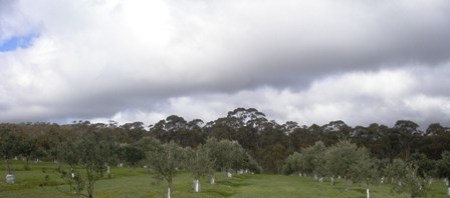We had a ripper of a lunch today, incredibly delicious, I tell you.
Do you know “The Philosophers Kitchen”, a wonderful cooking book ? Francine Segan has done a great job bringing to life recipes from ancient Greece and Rome.
You will not believe me, we had salmon with rasberry glace. Fish with a fruit sauce, you might ask? And you are right, I was sceptical as well but it’s an incredibly wonderful dish.
We had three more dishes from this cookbook though with some variations because we could not get all the necessary ingredients in Jakarta. The fish was served with rice and cucumber salad with coriander vinaigrette (Pythagoras suggested this dish) and a mushroom dish, ‘field and forest salad’.
First I though of a white wine, maybe a Chardonnay, but then I changed my mind and chose a Yarra Valley ‘Gulf Station Pinot Noir’ from the ‘Australian Winemaker of the Year 2007’, Steve Webber of DeBortoli Wines in Dixons Creek, a wine readily available from the duty free shops in Jakarta. It complemented the food perfectly. The rasberry sauce and the dark forest fruit aroma of the wine matched perfectly.
Here are the recipes (in abbreviated form):
You start with the ‘rasberry glaze’ ( a fruit sauce).
Heat 2 medium shallots in a pan in which you have heated 2 tablespoons of butter on low heat until the shallots are softened, add 1/2 cup of vinegar (ideally rasberry vinegar which, but we did not have this and used apple cider vinegar quite successfully), add 1/2 pint of fresh rasberries (frozen ones might also do, but the fresh stuff is much better) and cook for about 15 minutes. Then you have to press the liquid through a filter so that the solids can be removed, add a tablespoon of honey and some butter and keep the glaze warm.
Then you prepare the salmon (steaks or fillets) which need to be seared in hot olive oil.
The cucumber salad is made from European cucumber (cut very small, maybe graded in a food processor) with 2 ounces of feta cheese, 1/4 cup of heavy cream, add fresh cilantro leaves, some muscatel or sherry vinegar, coriander, extra virgin olive oil, lemon juice, a table spoon of honey, salt and freshly milled pepper (and golden raisins if you like, which we did not do).
For the mushroom salad we used fresh ‘portobello’ and enotaki mushrooms which were served in a olive oil vinaigrette with forest and garden herbs, freshly milled pink pepper and 2 tablespoons of finely chopped pistachio nuts.
The rasberrry sauce and the salmon harmonise wonderfully. It’s also a delight for the eyes, these colours are amazing. I tried to take photos and hope you get an idea what was served.

The salmon with the rasberry glaze

The mushroom salad
As you know, I am not the cook in our family. Margit surprised us all with these dishes. When she told me about it earlier, I somehow did not pay attention. But boy was that a delicious meal. If the old Romans ate like that, I would not mind having been born 2000 years ago. If you happen to visit us, we might surprise your tastebuds with salmon and rasberry sauce.
I wonder which Italian wine would have harmonised with this meal. Steve Webber’s Pinot Noir from the Yarra Valley was good enough and helped ‘to reach out’ from the old to the new world.
Well, I did not have access to any good bottle at the time, but maybe you can help me. Looking forward to your wine suggestions.




 Posted by themanfrommoselriver
Posted by themanfrommoselriver 














